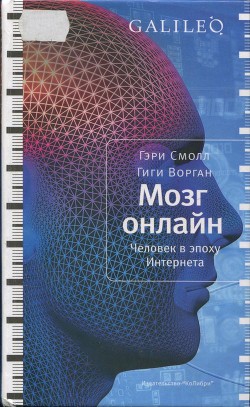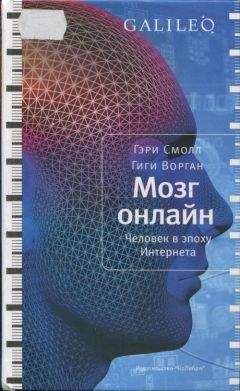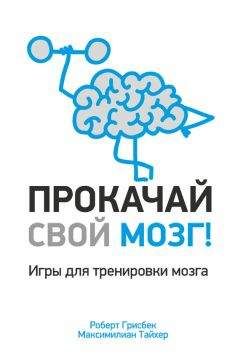Мозг онлайн. Человек в эпоху Интернета - Смолл Гэри

Помощь проекту
Мозг онлайн. Человек в эпоху Интернета читать книгу онлайн
25. Levy W.B., Baxter R.A. Using energy efficiency to make sense out of neural information processing. IEEE; IslT 2002, Lausanne, Switzerland, June 30— July 5, 2002, http://ieeexplore.ieee.org/iel5/7942/-21920/01023290.pdf
26. Vandewater E.A., Rideout V.J., Wartella E.A., Huang X., Lee J.H., Shim M.S. Digital childhood: Electronic media and technology use among infants, toddlers, and preschoolers. Pediatrics 2007; 119, p. 006–1015, http://pediatrics.aappublications.org/cgi/content/full/119/5/е1006
27. Roberts D.F., Foehr U.G., Rideout V. Generation M: Media in the lives of 8-18 year-olds. A Kaiser Family Foundation Study. 2005, www.kff.org/entmedia/upload/Generation-M-Media-in-the-Lives-of-8-18-Year-olds-Report.pdf
28. Fox S., Madden M. Generations online. Pew Internet & American Lite Project. December, 2005, http://www.pewinternet.org/pdfs/PIP_Generations_Memo.pdf
29. Thompson C. Meet the life hackers. The New York Times. October 16, 2005
30. Pressner J. C., Baldwin M.W., Dedovic K., et al. Selfesteem, locus of control, hippocampal volume, and cortisol regulation in young and old adulthood. Neuroimage 2005; 28:815-826
31. McEwen B.S. Protective and damaging effects of stress mediators: Central role of the brain. Dialogues in Clinical Neuroscience 2006; 8:367-81
32. Mednick S. C., Nakayama K., Cantero J. L The restorative effect of naps on perceptual deterioration. Nature Neuroscience 2002; 5:67-81
33. Sillence E., Briggs P., Harris P.R., Fishwick L How do patients evaluate and make use of online health information? Social Science & Medicine 2007; 64:1853-1862
34. Small G. W., Silverman D. H. S., Siddarth P., et al. Effects of a 14-day healthy longevity lifestyle program on cognition and brain function. American Journal of Geriatric Psychiatry 2006; 14:538-545
Haier R.J., Siegel B.V., MacLachlan A., et al. Regional glucose metabolic changes after learning a complex visuospatial/motor task: A positron emission tomographic study. Brain Research 1992; 570:134-143
35. Flynn J. R. The hidden history of IQ and special education: Can the problems be solved? Psychology, Public Policy and Law 2000; 6:191-198
36. Kearney P. Cognitive assessment of game-based learning. British Journal of Educational Technolog у 2007; 38:529-531
37. McClure S. М., Laibson D. I., Loewenstein G., Cohen J. D. Separate neural systems value immediate and delayed monetary rewards. Science 2004; 306:503-507
38. Roberts D.F., Foehr U.G., Rideout V. Generation M: Media in the lives of 8-18 year-olds. A Kaiser Family Foundation Study. 2005, www.kff.org/entmedia/upload/Generation-M-Media-in-the-Lives-of-8-18-Year-olds-Report.pdf
39. Bischof H. J. Behavioral and neuronal aspects of developmental sensitive periods. Neuroreport 2007; 18:461-465
40. National Endowment for the Arts. Reading at risk: A survey of literary reading in America: Research Division Report #46. National Endowment for the Arts. Washington, DC, June, 2004, www.nea.gov/pub/ReadingAtRisk.pdf
41. Zimmerman F. J., Christakis D. A., Meltzoff A. N. Television and DVD/video viewing in children younger than 2 years. Archives of Pediatric and Adolescent Medicine 2007; 161:473–479. Dan A. Videos as a baby brain drain. Los Angeles Times. August 7, 2007
42. Friedman T. L The World is Flat: A Brief History of the Twenty-First Century. Farrar, Straus and Giroux, New York, 2005
43. Cunningham F. G., McDonald P. C., Norman P. G. (eds): Williams Obstetrics. 21st ed. McGraw-Hill Medical Publishing, New York, 2001
44. Elkins D. Are we pushing our kids too hard? Psychology Today, 2006, http://psychologytoday.com/articles/pto-20030304-000002.html
45. American Academy of Pediatrics. Children, adolescents, and television. Pediatrics 2001; 107:423-426
46. Ginsburg H. P., Opper S. Piaget’s Theory of Intellectual
Development. 3rd ed. Prentice Hall, Englewood Cliffs, NJ, 1988.
47. Microsoft Corporation. The Market for Accessible Technology — The Wide Range of Abilities and Its Impact on Computer Use, www.microsoft.com/enable/research/default.aspx
48. Madden M. Internet penetration and impact. Pew Internet & American Life Project. April, 2006, www.pewinternet.org/pdfs/PIP_Internet_Impact.pdf
49. Shiu Lenhart A. How Americans use instant messaging. Pew Internet & American Life Project. September, 2004, www.pewinternet.org/pdfs/PIP_Instantmessage_Report.pdf
50. Roberts D.F., Foehr U.G., Rideout V. Generation M: Media in the lives of 8-18 year olds. A Kaiser Family Foundation Study. 2005, www.kff.org/entmedia/upload/Generation-M-Media-in-the-Lives-of-8-18-Year-olds-Report.pdf
51. Niemz K, Griffiths М., Banyard P. Prevalence of pathological Internet use among university students and correlations with selfesteem, the general health questionnaire (GHQ), and disinhibition. Cyberpsycholog у & Behavior 2005; 8:562-570
52. Koezuka N., Koo М., Allison K.R., et al. The relationship between sedentary activities and physical inactivity among adolescents: Results from the Canadian community health survey. Journal of Adolescent Health 2006;39:515-522
53. Grund A., Krause H., Siewers M., Rieckert H., Muller M.J. Is TV viewing an index of physical activity and fitness in overweight and normal weight children? Public Health and Nutrition 2001; 4:1245-1251
54. McGivern R.F., Andersen J., Byrd D., et al. Cognitive efficiency on a match to sample task decreases at the onset of puberty in children. Brain and Cognition 2002; 50:73-89
55. Blakemore S.-J., Choudhury S. Development of the adolescent brain: Implications for executive function and social cognition. Journal of Child Psychology and Psychiatry 2006; 47: 296-312
Den Ouden Frith U., Frith C., Blakemore S.-J. Thinking about intentions. Neuroimage 2005; 28:787-796
56. Abcarian R., Horn J. Underwhelmed by it all. Los Angeles Times. August 7, 2006. Piccalo G. Girls just want to be plugged into everything. Los Angeles Times. August ii, 2006
57. Tun P. A. Fast noisy speech: Age differences in processing rapid speech with background noise. Psycholog у and Aging 1998; 13:424-434
58. Foerde K., Knowlton B. J., Poldrack R. A. Modulation of competing mem— ory systems by distraction. Proceedings of the National Academy of Sciences USA 2006:103:11778-11783
59. Evers M. South Korea turns PC gaming into a spectator sport. Spiegel Online International, http://www.spiegel.de/intemational/spiegel/o,1518,399476,00.html
60. Mori A. Terror of Game-Brain. NHK Books, Tokyo, Japan. 2002. Matsuda G. Hinaki K. Neuroimage 2006; 29:706-711

























